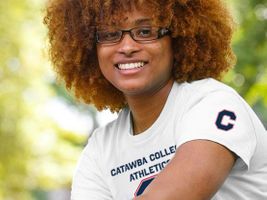By Shannon Garrick '17
This spring marked the first time that an entomology course has been offered at Catawba College. The course, taught by associate professor of biology and environmental science Dr. Sue Calcagni, focused on the practical applications of insects and other organisms often thought of as "bugs." Students in the class had the opportunity for some hands-on experiences in the lab and completed two semester-long projects.
The first part of the semester focused on learning about insects. The students began with the importance of insects, ranging from their role in pollination, disease transmission, natural pest control to their being a huge part of other cultures’ diets. Some of the topics discussed included the nomenclature and major classifications of insects, insect anatomy (both internal and external) and physiology, insect behavior, and social insects.
The latter part of the semester covered the study of spiders, which are not insects but are found in the same phylum (Phylum Arthropoda). Students learned the basic biology of spiders, including anatomy and physiology, classification based on spider families, and the behaviors of spiders. They also learned about spider silk, which has many practical uses for the spiders and may also be useful in biomedical applications.
To supplement the lectures, students brought in live specimens for the class to view. Students also had the opportunity to look at photos and short video clips taken by Calcagni and to use the dissecting microscopes to look at collected specimens and learn more about their physical features.
During the course of the semester, the students completed two projects. For the first project, pairs of students created an educational brochure or handout about an insect or spider that was interesting to them. Some of the insects included the crazy raspberry ant, Mexican bean beetle, rose-haired tarantula, and the green lynx spider. A variety of information was included in the final product, including the ecology, notable aspects, and the physical features of the species. Each pair of students gave a presentation to the class to supplement the brochures/handouts that were created.
The second project of the semester was creating a photographic database of insects and spiders around campus and in the Fred Stanback, Jr. Ecological Preserve. Each student was asked to find five arthropods, for a total of 80 specimens from the entire class. For this project, students had to find the insects, take pictures, and identify them using the www.bugguide.net website to help with identification. After arriving at the correct identification, students then created a PowerPoint slide to go into the database.
The semester was successful in teaching students the importance of insects and spiders, such as how they keep ecological systems in order and provide important benefits, including acting as natural pest control and having applications in the field of biomedical research. In addition, the students learned that insects and spiders are very beautiful when seen up close and very few are truly dangerous.
